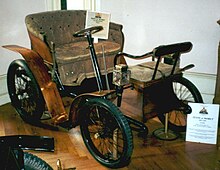Vis-à-vis (carriage)

A vis-à-vis is a carriage in which the passengers sit face to face with the front passengers facing rearward and the rear passengers facing forward.[1] The term comes from the French vis-à-vis, meaning face to face.[1][2]: 28
These carriages are still commonly made by Amish carriage makers in the midwestern United States.[citation needed] Also in the Western world, the vis-a-vis is the most common type of carriage style used to cart tourists and leisure seekers in downtown urban settings.
Passengers sit back-to-back on dos-à-dos carriages.
Examples
The following types of carriage had vis-à-vis seating:
Automobiles

There were vis-à-vis automobiles in the early history of motoring.[2]: 28 These were driven from the forward-facing rear seat, with front passengers sitting ahead of the steering controls and facing the driver.[1][2]: 28 [3] Passengers in the front seat would obstruct the vision of the driver in the rear seat, and the style fell out of favour before 1905.[1][2]: 27-28
See also
References
- ^ a b c d Haajanen, Lennart W. (2003). Illustrated Dictionary of Automobile Body Styles. Illustrations by Bertil Nydén; foreword by Karl Ludvigsen. Jefferson, NC USA: McFarland. p. 155. ISBN 0-7864-1276-3. LCCN 2002014546.
- ^ a b c d Beattie, Ian (1977). The Complete Book of Automobile Body Design. Yeovil, UK: The Haynes Publishing Group. ISBN 0854292179.
- ^ Culshaw, David; Horrobin, Peter (2013) [1974]. "Appendix 5: Coachwork Styles". The Complete Catalogue of British Cars 1895 - 1975 (e-book ed.). Poundbury, Dorchester, UK: Veloce Publishing. pp. 480–484. ISBN 978-1-845845-83-4. |page=484
